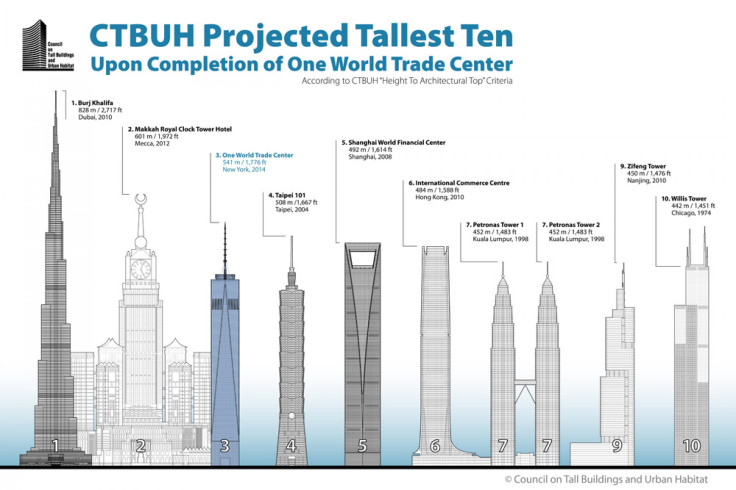Why One World Trade Center Almost Didn’t Qualify As Tallest Building In The US

The Chicago-based Council on Tall Buildings and Urban Habitat announced Tuesday that New York’s One World Trade Center would officially become the tallest U.S. skyscraper upon completion next year. The ruling, while expected, was by no means guaranteed.
CTBUH’s Height Committee gathered in Chicago last week both to revaluate its criteria for determining the height of buildings and to rule on the official height of One World Trade Center. Specifically, the organization needed to discuss the nature of the mast structure on top of the tower after design changes resulted in the removal of the architectural cladding, making it unclear whether the structure was in fact a “spire.”
In order for One World Trade Center to claim its architectural top at 1,776 feet (an homage to the year the U.S. declared independence), CTBUH said it had to determine that the mast was indeed “a permanent architectural feature, not a piece of functional-technical equipment.” That took a bit of convincing from One World Trade Center’s owner and design team, including the project’s chief architect, David Childs of Skidmore, Owings & Merrill LLC and Ken Lewis, project director at the firm.
The spire-antenna distinction, CTBUH said, makes a difference in the measurement of “height to architectural top,” which includes spires but not antennae, signage, flagpoles or other functional technical equipment. Were One World Trade Center’s mast deemed “functional-technical,” its architectural top would have been the roof slab at just 1,334 feet, 8 inches, making the building 441 feet, 4 inches lower than claimed.
CTBUH Executive Director Antony Wood said a team of delegates sent to Chicago was able to convince a panel of 25 architects and engineers that the mast was indeed a permanent spire. “The design of One World Trade Center, as explained to us, reinforces its role as a symbol of resurgence on this important site,” Wood stated Tuesday. “In particular, the spire which holds the beacon light, shining out at the symbolic height of 1,776 feet, is especially poignant -- echoing the similarly symbolic beacon atop the Statue of Liberty across the water.”
One World Trade Center rises above the site of the original World Trade Center, whose twin towers fell in the terrorist attacks of Sept. 11, 2001. The nearly 3,000 people killed in the tragedy are commemorated in a memorial at the base of the new structure.
It was formerly to be called the Freedom Tower, but the Port Authority of New York and New Jersey changed the name in 2009 to make the building more marketable for tenants. When completed and occupied in early 2014, One World Trade Center will surpass The Willis (formerly Sears) Tower in Chicago as the tallest in North America. It will also become the third tallest building in the world after the Burj Khalifa in Dubai (2,717 feet) and the Makkah Royal Clock Tower in Mecca (1,972 feet), according to CTBUH.
Where One World Trade Center to be measured without its spire -- or without what CTBUH calls “vanity height” -- it would not be the tallest in the U.S., much less the world. Even with the spire, building database Emporis says that four buildings under construction in China and one in South Korea will surpass One World Trade Center’s height in the coming years.
© Copyright IBTimes 2024. All rights reserved.






















